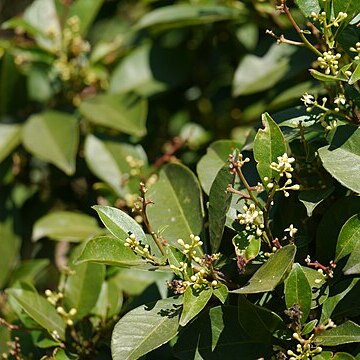Shrub, or tree to 8 m high, evergreen. Older stems often with thick conical spines; branchlets unarmed or with spreading or ascending prickles. Leaves trifoliolate (occasional or rather frequent leaves bifoliolate or simple), 7.5–21 cm long; leaflets sessile or terminal leaflet with petiolule to 5 mm long; laminae elliptic to obovate, 6–18 cm long, 2.5–7 cm wide, acute to attenuate at base, entire to crenate, acute to acuminate. Inflorescences terminal or terminal and axillary, paniculate, to 12 cm long; pedicels 2.5–4 mm long, 0.15–0.3 mm wide (2.5–5 mm long, 0.5–0.8 mm wide in fruit). Sepals distinct or basally connate, 0.5–1 mm long. Petals c. 2.5 mm long, white. Male flowers: stamens 2.5–3 mm long; disc ovoid or bell-shaped, 0.5–0.6 mm high, entire or 8-lobed at base; rudimentary gynoecium 1-carpelled, narrowly ovoid, c. 0.5 mm long. Female flowers: rudimentary stamens ligulate, to 1 mm long or lacking; disc columnar, 0.3–0.8 mm high, entire or inconspicuously ridged; gynoecium 1-carpelled, 1.5–2 mm long; style excentric; stigma capitate. Follicles single, globose, 6.5 mm diam., red, purple, or brown. Seeds globose, with rather thin sclerotesta; endosperm scant. Embryo with cotyledons plano-convex, orbicular in outline.
More
A large shrub. It can be a climber. It has short prickles. The leaves have 3 leaflets The leaflets are 7-10 cm long by 2-5 cm wide. They are narrowly oval and scalloped along the edge. The leaf stalks are stout and 3 cm long. The flowers are in dense groups on branched stems. They are white. The fruit occur singly and are round.
Monsoon forests and thickets at elevations up to 1,750 metres in Malesia and from 1,000-2,000 metres in continental Asia
More
It is a tropical plant. It occurs in the Western Ghats in India.
Grows in rainforest, 100–1260 m altitude.



